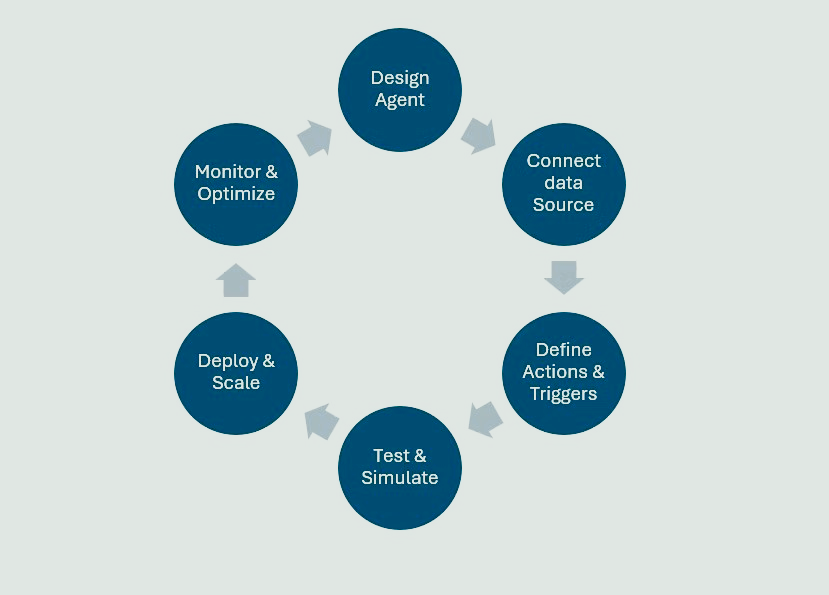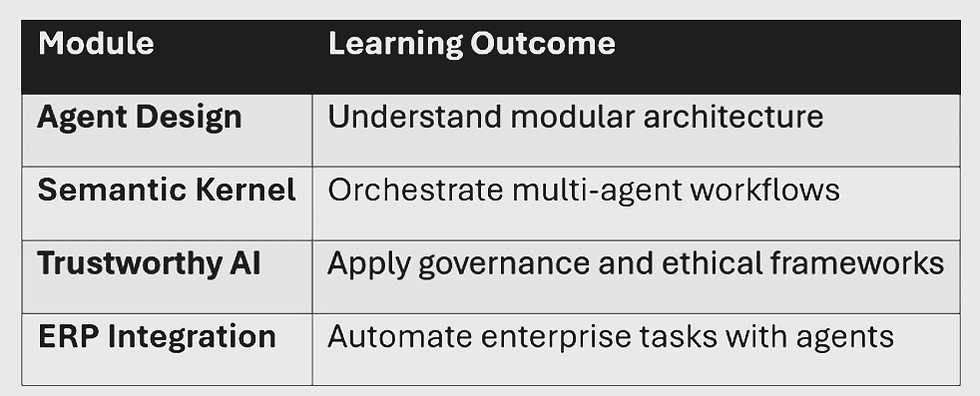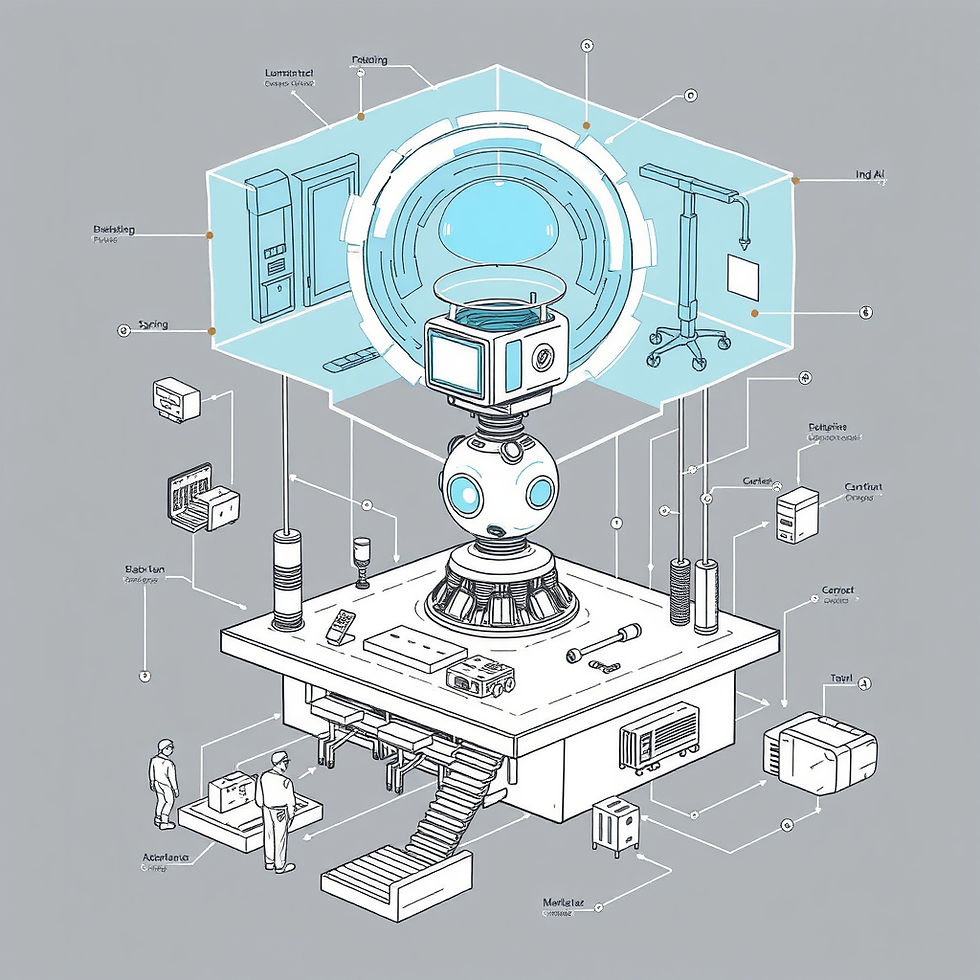Agentic AI in Enterprise Transformation: A Deep Dive into Azure AI Foundry
- subrata sarkar
- Sep 24
- 3 min read
Abstract
Agentic AI represents a transformative leap in artificial intelligence, enabling autonomous systems that reason, plan, and act across complex enterprise workflows. This paper explores the architecture, capabilities, and enterprise applications of Microsoft’s Azure AI Foundry—a platform designed to build scalable, trustworthy agentic systems. Through comparative analysis, lifecycle modeling, and real-world use cases, we demonstrate how Azure AI Foundry empowers developers and architects to orchestrate intelligent automation across ERP, HR, and academic domains.
1. Introduction
Artificial intelligence has evolved from reactive assistants to proactive agents capable of autonomous decision-making. This shift—termed agentic AI—is reshaping enterprise transformation by enabling systems that not only respond but also initiate, coordinate, and optimize tasks across domains.
Microsoft’s Azure AI Foundry, launched in 2024, provides a modular infrastructure for building agentic applications. It integrates orchestration frameworks, pretrained models, and governance tools, making it a strategic enabler for intelligent automation.
2. Agentic AI Architecture
Agentic AI systems comprise six core components:
Knowledge: Retrieval from structured and unstructured enterprise data.
Models: Foundation models for reasoning and planning.
Actions: Execution via APIs, connectors, and workflows.
Memory: Threaded context for personalization and continuity.
Orchestrators: Multi-agent coordination across systems.
UX Layer: Human-agent interaction via prompts and feedback loops.
Insert Figure 1: Agentic AI Architecture Diagram
This modular design allows agents to operate autonomously while remaining aligned with enterprise goals and governance.
3. Azure AI Foundry: Platform Overview
Azure AI Foundry offers:
Semantic Kernel Agent Framework: Enables multi-agent orchestration.
Visual Studio & GitHub Integration: Streamlines development.
AI Red Teaming: Embeds trust and security into agentic workflows.
Insert Table 1: Azure AI Foundry vs Traditional AI Platforms

Foundry’s infrastructure supports both low-code and pro-code development, making it accessible to diverse teams.
4. Enterprise Use Cases
4.1 ERP Orchestration
In D365 F&O, agentic systems automate procurement, inventory reconciliation, and compliance reporting. Agents can monitor vendor performance, trigger alerts, and suggest alternate sourcing strategies.
4.2 HR & IT Service Management
Atomicwork’s agent “Atom” automates onboarding, internal requests, and employee support, reducing ticket resolution time by 40% (Atomicwork, 2025).
4.3 Academic Institutions
Universities deploy agents for grading, onboarding, and research analytics. Azure AI Foundry’s templates enable rapid deployment of domain-specific agents.
5. Agent Lifecycle in Azure AI Foundry
Insert Figure 2: Agent Lifecycle Flowchart

Each stage is supported by templates, connectors, and orchestration tools. Foundry’s managed infrastructure ensures scalability and compliance.
6. Trustworthy AI and Governance
Azure AI Foundry integrates AI Red Teaming to ensure ethical and secure agent behavior. Key features include:
Identity Management: Enterprise-grade authentication.
Audit Trails: Transparent logs of agent decisions.
Bias Mitigation: Model tuning and fairness checks.
These features are essential for regulated industries such as finance, healthcare, and government.
7. Academic Integration
Agentic AI is reshaping pedagogy in computer science and business schools. Azure AI Foundry offers:
QuickStart Modules: For building agents with low-code tools.
Semantic Kernel Demos: For orchestration and autonomy.
Research Opportunities: In multi-agent systems and ethical AI.
Insert Table 2: Agentic AI Curriculum Integration

8. Global Adoption and Future Outlook
Over 60,000 organizations are building agentic applications on Azure AI Foundry. Its modularity and compliance readiness make it ideal for cross-regional deployments—from India’s manufacturing hubs to Europe’s public sector digitization.
Future Trends
Agentic ERP: Autonomous supply chain orchestration.
Agentic Research Assistants: For academic writing and synthesis.
Agentic Compliance Agents: Real-time regulatory monitoring.
9. Challenges and Considerations
Despite its promise, agentic AI faces hurdles:
Data Silos: Integration across legacy systems remains complex.
Human-AI Collaboration: Requires cultural shifts in workflows.
Ethical Dilemmas: Autonomous decisions must be explainable and fair.
Azure AI Foundry addresses these through orchestration layers, trust modules, and developer tooling.

10. Conclusion
Agentic AI, powered by Azure AI Foundry, marks a paradigm shift in enterprise automation. By enabling autonomous, trustworthy, and scalable agents, it transforms how organizations operate, innovate, and educate. For architects, educators, and developers, this is not just a technological evolution—it’s a strategic imperative.
References
Atomicwork. (2025). Agentic AI in HR Automation. Retrieved from Atomicwork Blog
Microsoft Education Blog. (2025). Discover the Potential of Agentic AI in Higher Education. Retrieved from Microsoft Education
TechyNerd. (2025). Azure AI Foundry Empowers Developers. Retrieved from TechyNerd
Microsoft Partner Resources. (2025). AI & ML Academy: Agentic AI Overview. Retrieved from Microsoft GitHub



Comments